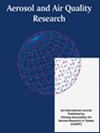Emission Characteristics, OFPs, and Mitigation Perspectives of VOCs from Refining Industry in China's Petrochemical Bases
IF 2.5
4区 环境科学与生态学
Q3 ENVIRONMENTAL SCIENCES
引用次数: 0
Abstract
China's petroleum refining industry has set off another climax and has entered a new rapid development by building seven petrochemical bases. Sector-based volatile organic compound (VOC) emissions from the refining industry in seven petrochemical-developed provinces in China were estimated for 1990–2019 and projected for 2020–2030 under the business-as-usual (BAU), new policy control (NPC), and the highest control (HC) scenarios. Furthermore, speciated VOCs and their ozone formation potentials (OFP) were estimated in 2019. Total VOC emissions from existing refineries were 541.14 Gg in 2019, of which 43.9%, 31.3%, 18.3%, and 6.6% were from fugitive, end-of-pipe, tank storage, and wastewater treatment sources, respectively. Alkanes were the most dominant compound in refineries, accounting for 55.2% of total emissions, followed by alkenes (18.9%) and aromatics (12.5%). Alkenes were the highest contributor to OFP, accounting for 59.5% of total OFP, followed by alkanes (22.3%) and aromatics (13.7%). n-Butane, ethylene, cis-2-Butene, n-Decane, and n-Pentane were the top five species with the highest emissions, accounting for approximately 50% of total emissions. Whilst, ethylene, cis-2-Butene, n-Pentane, n-Butane, and m/p-Xylene were the top five species with the highest contribution to OFPs, accounting for approximately 78% of total OFPs. In 2030, 741.03 and 165.28 Gg more VOC will be released than in 2019 under a non-control condition and the BAU scenario. It is estimated that 75.05 and 228.67 Gg of VOC from all refineries can be reduced under the NPC 2030 and the HC 2030 scenarios. To effectively reduce VOC emissions from refining industries, priority should be given to fugitive emissions by improving and upgrading the production processes and implementing enhanced leak detection and Repair system. More efficient control technologies should be invented for end-of-pipe sources. Vapor recovery systems and secondary seals have great potential for VOC emission reduction from storage tanks.中国石化基地炼油行业VOCs排放特征、OFPs及减排前景
本文章由计算机程序翻译,如有差异,请以英文原文为准。
求助全文
约1分钟内获得全文
求助全文
来源期刊

Aerosol and Air Quality Research
ENVIRONMENTAL SCIENCES-
CiteScore
8.30
自引率
10.00%
发文量
163
审稿时长
3 months
期刊介绍:
The international journal of Aerosol and Air Quality Research (AAQR) covers all aspects of aerosol science and technology, atmospheric science and air quality related issues. It encompasses a multi-disciplinary field, including:
- Aerosol, air quality, atmospheric chemistry and global change;
- Air toxics (hazardous air pollutants (HAPs), persistent organic pollutants (POPs)) - Sources, control, transport and fate, human exposure;
- Nanoparticle and nanotechnology;
- Sources, combustion, thermal decomposition, emission, properties, behavior, formation, transport, deposition, measurement and analysis;
- Effects on the environments;
- Air quality and human health;
- Bioaerosols;
- Indoor air quality;
- Energy and air pollution;
- Pollution control technologies;
- Invention and improvement of sampling instruments and technologies;
- Optical/radiative properties and remote sensing;
- Carbon dioxide emission, capture, storage and utilization; novel methods for the reduction of carbon dioxide emission;
- Other topics related to aerosol and air quality.
 求助内容:
求助内容: 应助结果提醒方式:
应助结果提醒方式:


